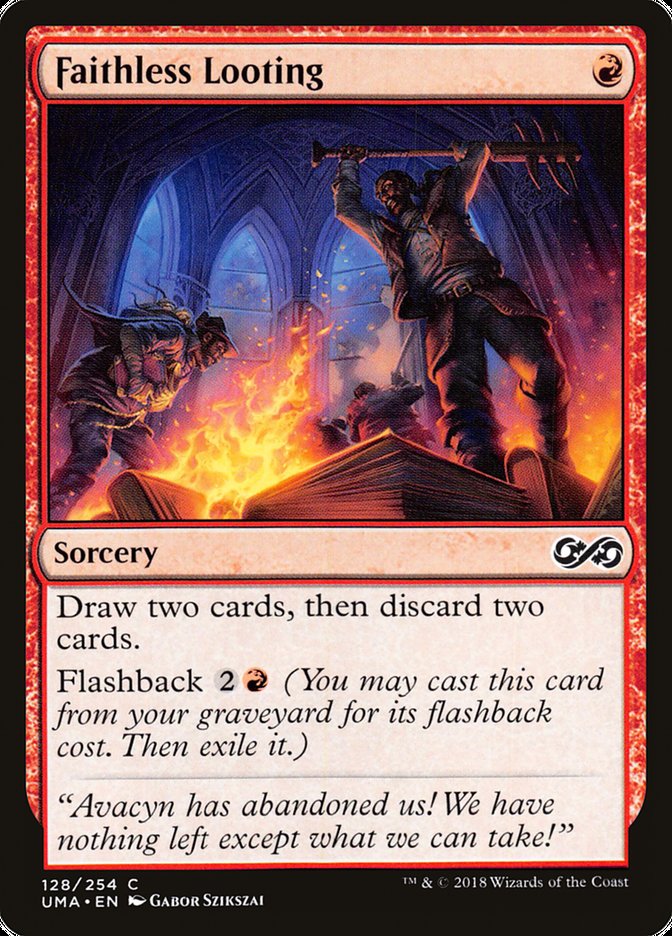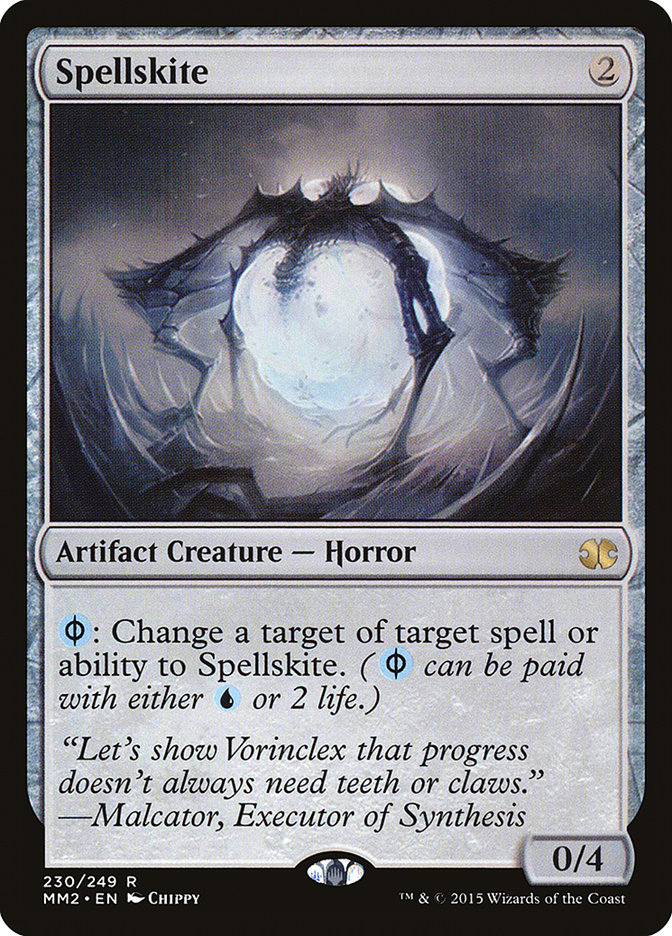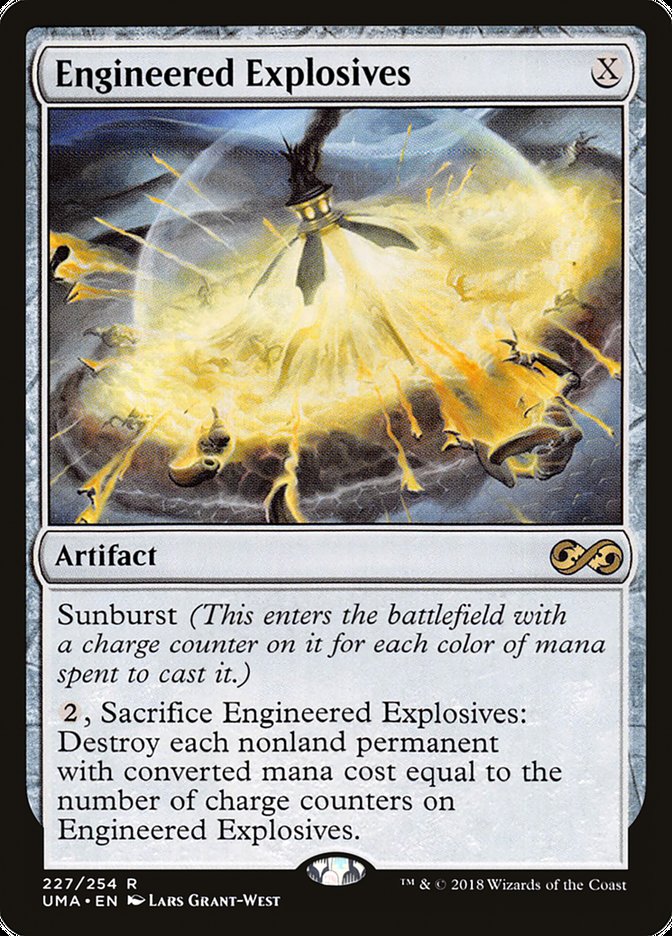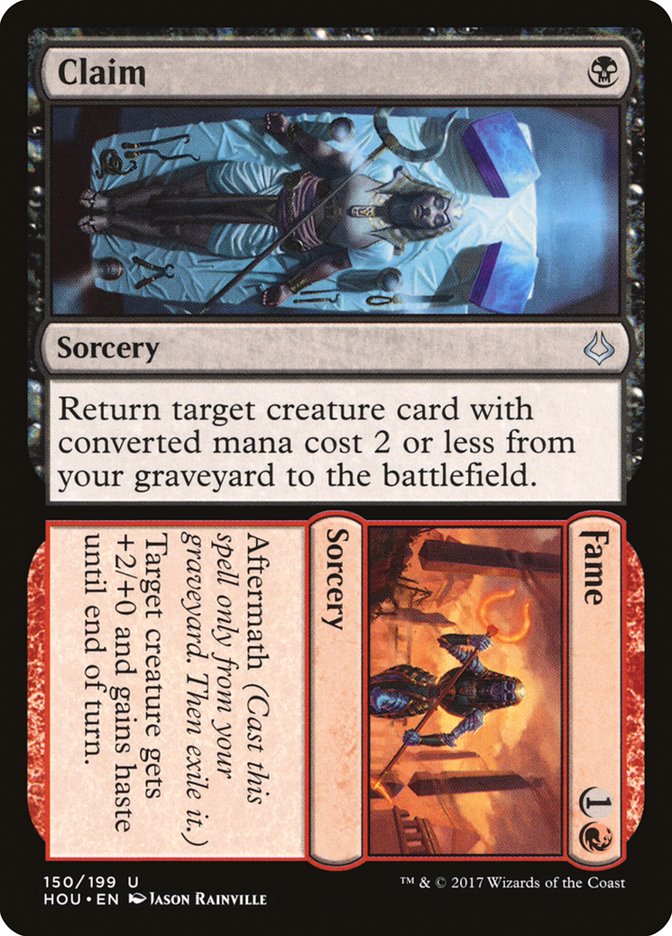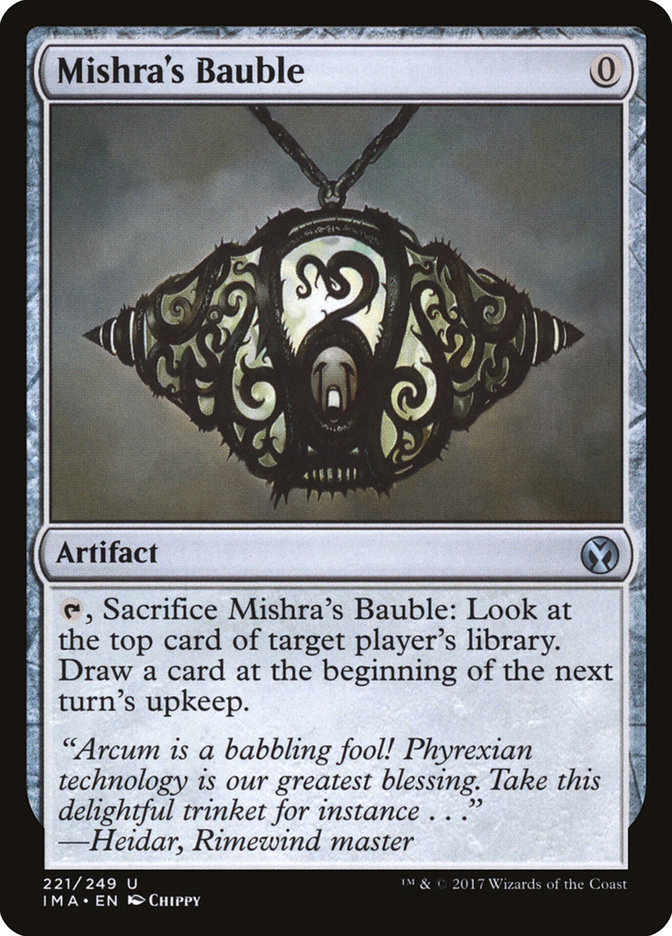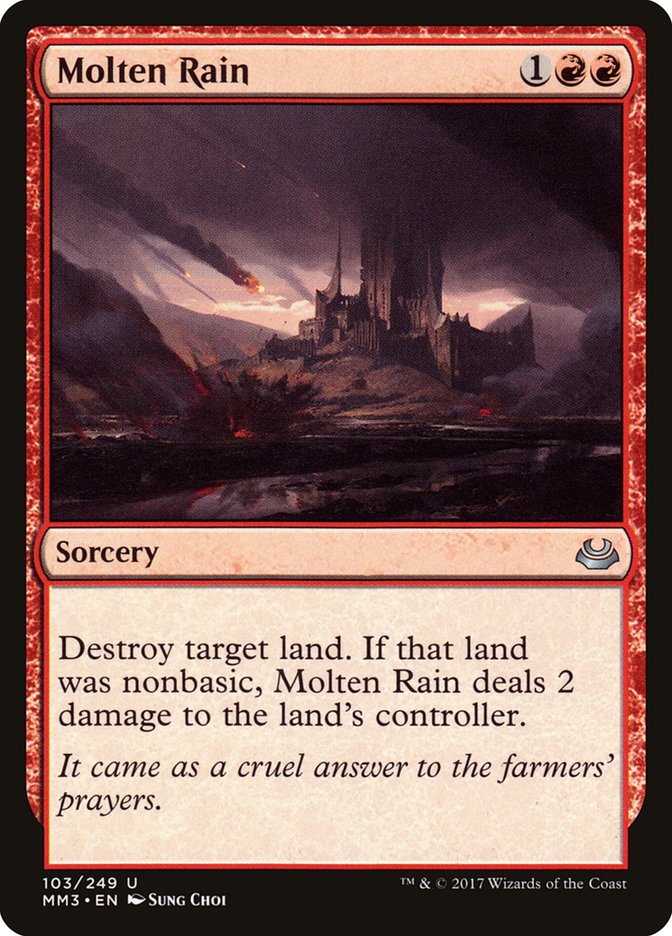This past weekend, I decided to expand my range in Modern and pick up the powerful, multifaceted Izzet Phoenix for Grand Prix Los Angeles. It wasn’t a decision I made lightly, as my Grixis Death’s Shadow deck has become like a beloved old friend. However, I recognize that Faithless Looting is Modern’s Brainstorm, and as such it would be foolish to dismiss the deck with (arguably) the best card selection in the format. A full third of the deck is cheap cantrips, the deck strains the normal rules of engagement when it comes to some of the more busted sequences, and a few key upgrades put it over the top. In terms of power, consistency, and ability to incorporate divergent gameplans to combat hate, Izzet Phoenix equals or supersedes Grixis Death’s Shadow on all counts.
The tip-top nut draws of Izzet Phoenix involve three (or in that ultra-rare one-in-1000 game, four) Arclight Phoenixes attacking on Turn 2, essentially winning the game on Turn 3. Similarly, Grixis Death’s Shadow’s ceiling involves an angry Death’s Shadow attacking for twenty damage on Turn 3 (usually with three fetchlands, a Dismember, and a mix of Street Wraith and Thoughtseize to drop you down to three life).
The floor of Grixis Death’s Shadow involves flooding out, drawing all removal against a control deck or Tron, or drawing all Stubborn Denials against Humans. It’s not a pretty picture, and Izzet Phoenix has a significantly lower percentage of non-games due to Faithless Looting’s ability to mitigate mana issues. One can play Faithless Looting in Death’s Shadow, of course, and I heartily endorse a copy or two, but Grixis Death’s Shadow has no natural way to recoup card disadvantage outside of Snapcaster Mage and a few sideboard cards, thus making the drawback sting significantly more.
Grixis Death’s Shadow also often operates like a Jund deck, trading resources and hoping to win by pinning the opponent on one axis of the game. It could be one extra unanswerable threat, one turn where double Stubborn Denial pins them on mana, or a simple tempo advantage caused by deploying multiple one-mana spells in a single turn. Faithless Looting plays into none of these goals. Of course, Izzet Phoenix embraces the drawback of Faithless Looting, turning it into a source of free firebirds and a key cog in the best draws the deck can produce, thus flipping the tempo-negative and card-negative aspects of the card.
And of course, in terms of vulnerability to sideboard hate, Death’s Shadow and Thing in the Ice both offer non-graveyard-reliant avenues to victory against cards like Rest in Peace or Leyline of the Void, but where Grixis Death’s Shadow sometimes gets stuck with uncastable Gurmag Anglers in the face of a Leyline, Izzet Phoenix can just hardcast its namesake card, transform a Thing in the Ice, or win with a Crackling Drake to sidestep targeted hate.
I’m not saying that Grixis Death’s Shadow is a bad deck. On the contrary, it’s an incredible deck. I’m simply being a realist about the issues that crop up with it, issues that may not occur at the same frequency in Izzet Phoenix.
For a long time, though, I was skeptical of some of the weaker cards in the Phoenix deck. That changed when Dylan Donegan reminded me that Snapcaster Mage is a legal card in all Modern decks, not just my favorite one! Obviously, I’m thrilled to play Snapcaster Mage, especially in concert with so many cheap spells, and love the combined impact of a super-heavy cantrip deck and Snapcaster Mages on the virtual density of certain sideboard cards. I’m talking about Surgical Extraction, in particular, but three or four sideboard counterspells go a long way with so much selection and Flashback.
I was frustrated with how Grixis Death’s Shadow had to stretch so far to accommodate sideboard cards for the wide range of linear strategies in Modern. There are graveyard decks, big mana decks, artifact decks, swarm decks, and Burn. There’s never quite enough room to cover everything in a satisfactory way in Modern, unfortunately, but this is where I left off with Death’s Shadow before picking up Phoenix.
Creatures (16)
Lands (17)
Spells (27)

Spellskite and Engineered Explosives are hedges for the other deck I briefly considered for this tournament – but shelved due to timing out every time I attempted to play it on Magic Online – Whir Prison. Incidentally, Whir Prison is one of the few decks in Modern, along with Amulet Titan, that can challenge Izzet Phoenix and its Faithless Lootings on the metric of card selection. Ancient Stirrings is another messed-up Magic card!
Spellskite redirects Welding Jar, allowing an Explosives on three to get through and break an Ensnaring Bridge. Shatterstorm is another acceptable hedge for Whir, but Spellskite has cross-applications against a weird mix of decks like Burn, Infect, Selesnya Hexproof, and more. Same with Engineered Explosives, which can randomly kill a bunch of Slippery Bogles and Gladecover Scouts or a bunch of Ensnaring Bridges with equal ease.
Claim // Fame is my surprise one-of, and Jace, Vryn’s Prodigy offers both card selection and the Snapcaster effect. It impressed me enough in Legacy Dimir Death’s Shadow to warrant a trial spot on the starting lineup in Modern as well.
I remain attached to my four Mishra’s Bauble, and will be hard-pressed to cut a zero-mana pseudo-Opt with Suspend 1/2, but it could be cut for a fourth Thought Scour, a Faithless Looting, or an Izzet Charm with little argument.
I’d be happy to play Grixis Shadow at a Modern event soon, and I may yet run it back, but Izzet Phoenix has more room for wholesale improvements, rather than the nitpicking and matchup-percentage-pushing that seems to have overtaken real innovation in Grixis Death’s Shadow.
Snapcaster Mage is a major turning point. Maindeck Surgical Extraction over Gut Shot is another completely unconscionable (by traditional metrics) decision that actually looks genius in the right metagame. Heck, people are still debating whether a green splash for Life Goes On over Dragon’s Claw is worth it, Ryan Overturf won the Baltimore Team Constructed Open with a Traverse the Ulvenwald version of the deck, and Owen Turtenwald played one Leyline of the Void and one Leyline of Sanctity in his sideboard for the ultimate head-scratcher! It’s clear that Izzet Phoenix is not quite refined to the point of perfection yet, and we’ve got a long way to go and a lot of cards to try if we’re going to find the optimal build.
This past weekend, I played the following list:
Creatures (11)
Planeswalkers (2)
Lands (18)
Spells (29)

Chandra, Torch of Defiance was my attempt to find a one-card divergent gameplan that could sidestep hate and offered a built-in Flame Slash for the mirror. I chose Chandra over Jace, the Mind Sculptor because of this built-in Flame Slash effect, reasoning that Thing in the Ice and Crackling Drake would be more prevalent enemy cards than Gurmag Angler or Tarmogoyf.
I was disappointed with her, unfortunately. The mana boost on a subsequent turn was nice to have, but I suspect a Brainstorm off Jace would have been unfathomably good in comparison. Chandra got hit with Celestial Purge out of Jeskai Control, where a five-loyalty Jace would have absolutely run over my opponents. And of course, there was that pesky Tarmogoyf that just couldn’t be killed. What a fool I was. Patrick Chapin said it best. “Jace, the Mind Sculptor, better than all.”
I’ll be moving forward with one Crackling Drake and one Big Papa Jace in those slots. Every blue deck needs an ace up its sleeve, and as Shuhei Nakamura is fond of saying, pocket Queens (even a pair of red Queens like Chandra) just don’t cut it these days.
今日のQQ
新卓6人でmpから4BBに1人なんでもコールさんが入ってるところでSBから
3ベットしたいんだけど直近で3ベット2回やってるので今回はコールにするか…AJJ
お疲れ様でした
— shuhei nakamura (@Nakashu_) March 5, 2019
If you aren’t following Shuhei on Twitter, you can attempt to parse his bad-beat poker stories with Google Translate, but they usually involve him losing with QQ. I favorite them all out of principle.
On the other hand, I was pleased with my last-minute shift from Blood Moon to Molten Rain. Blood Moon was primarily there to hit Tron and Amulet Titan hard, but both decks pack preemptive countermeasures to this common hate card. Tron decks already want to resolve an Oblivion Stone to bridge from the early turns to an unbeatable mid-/late-game. Blood Moon only plays into this plan, leaving you unable to commit further to the battlefield while allowing Tron plenty of time to patiently blow up the world and untap with an Ulamog ready to go.
Additionally, Izzet Phoenix is priced into keeping in a couple of Surgical Extractions to try to cheese out an opponent with a lucky raw Thought Scour plus Surgical Extraction to strip them of all of one Tron piece. This is an extremely low-percentage play and often results in wasting cards or mana for basically no gain.
With Molten Rain, though, you can keep in your Surgical Extractions with pride, knowing that you now have realistic avenues for stripping your opponent of their mana engine. A Turn 3 Blood Moon on the play offers the opponent a chance to ruin you with a Turn 3 Oblivion Stone. A Turn 3 Molten Rain plus Surgical Extraction on the play, though? Game over. Those Karns are never coming down.
Oh, and I used Molten Rain to great effect against my one Whir Prison opponent, sticking them on insufficient lands to cast all the Whirs and Tezzerets in their hand and unlocking my Arclight Phoenixes to attack under an Ensnaring Bridge. Score!
Despite playing well and drawing well on the first day, I did neither of these on the second, punting my way to an ignominious 10-5 result by throwing away games to Dredge, Jeskai Control, and Humans. This deck is tough!
There are loads of narrow, powerful, and fun one-ofs you can play in Izzet Phoenix, which is possibly the most accommodating to odd singletons of any Modern deck I’ve ever seen. Owen Turtenwald had a single Twisted Image, an Izzet Charm, and a Pyromancer Ascension. I love all these cards, but Pyromancer Ascension offers the highest ceiling. I’d cautiously allow myself to cut one of my precious Snapcaster Mages to incorporate this engine-in-a-box card that completely upends a few matchups if it sticks.
Pteramander isn’t my cup of tea in this deck, though. It doesn’t win the game in one shot like Crackling Drake, doesn’t offer redundancy like Snapcaster Mage, and doesn’t dodge creature removal like Jace and Pyromancer Ascension do. I’m not seeing the love for this creature, since if you deploy it early it gets bounced by your own Thing in the Ice, and even in Super Saiyan mode it’s still vulnerable to all the best removal (Fatal Push, Dismember, Lightning Axe).
Spell Pierce was also underwhelming, and I’ll move forward with two Dispel and one Disdainful Stroke. Pierce does a few things well, but you’re often priced into tapping out on Turn 1 or 2 in order to cast your cantrips and Dispel is significantly better after those first crucial turns. It’s also much better in the mirror match, Storm, Jeskai Control, and Grixis Death’s Shadow, all challenging matchups that merit minor hedges to improve them.
But there are so many cool cards out there that merit consideration! Piracy Charm; Goblin Rabblemaster; the Traverse the Ulvenwald plus Mishra’s Bauble Temur package; Jace, Vryn’s Prodigy; Ancestral Vision; Threads of Disloyalty; Vedalken Shackles; Empty the Warrens; Young Pyromancer; Echoing Truth; Leyline of the Void; Ravenous Trap; Leyline of Sanctity; True-Name Nemesis (Just kidding! Can you imagine?).
The list goes on and on!
Modern isn’t necessarily in the healthiest place in terms of the relative power level of some particular cards and strategies, but it’s a fine time to be a deck brewer and tuner as we move towards Mythic Championship London and the exciting/terrifying new mulligan rule. More on what that nifty little piece of R&D legislation could do to ol’ Modern next time, as I still have to wrap my brain around how to properly combat a Dredge deck that can happily mulligan to four and still win with ease. I’m cautiously optimistic, but ready to see a lot of matches where the mulligan process takes longer than the game itself.
It’s going to be a brave new Modern, that’s for sure.


